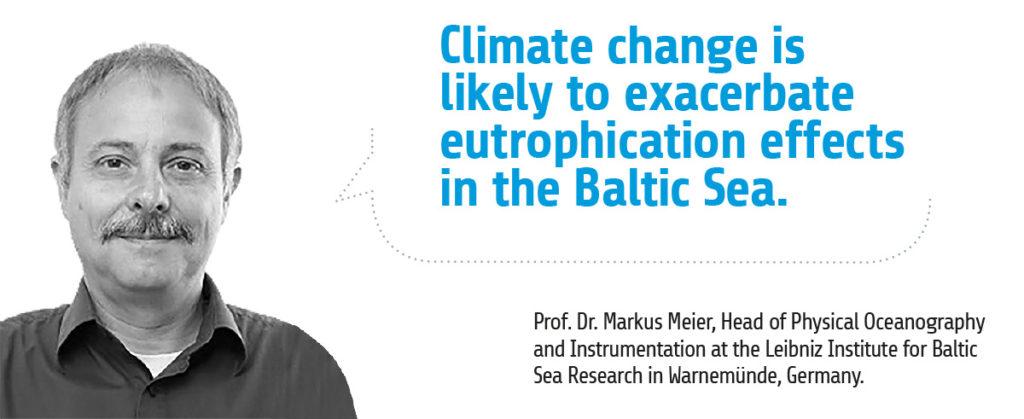
Prof. Dr. Markus Meier is the Head of Department of Physical Oceanography and Instrumentation at the Leibniz Institute for Baltic Sea Research in Warnemünde, Germany. He also is the co-Chair of the HELCOM Expert Network on Climate Change (EN CLIME) and the Chair of the Baltic Earth Science Steering Group (BESSG).
- Q: Climate change and the Baltic Sea: what are the facts and trends, what do we know?
Markus Meier (MM): According to the conclusions of the BACC II Author Team (2015), water temperatures of the Baltic Sea have been increasing during the past 100 years and are projected to further increase during the 21st century. According to recent future scenario simulations, ensemble mean changes in sea surface temperature averaged over the Baltic Sea between 1978-2007 and 2069-2098 range between 1.8 and 3.1°C depending on the underlying greenhouse gas emission scenario. Correspondingly, the annual maximum sea-ice extent has significantly declined during the past decades and will further decline in the future. Projections suggest that at the end of the century the Bothnian Sea and large areas of the Gulf of Finland and Gulf of Riga will become ice-free during normal winters. Past salt water inflows and observed salinities in the Baltic Sea do not show statistically significant trends but large multi-decadal variations on the time scale of about 30 years. According to the BACC II Author Team (2015), it is still unclear whether Baltic Sea salinity will increase or decrease as climate models have severe biases with regard to the freshwater balance. Since the beginning of Baltic tide gauge measurements in 1886, the mean sea level in the Baltic Sea has increased by more than 0.2 m and, for the 21st century, an accelerated sea-level rise is projected. However, the projections are highly uncertain and in the northern Baltic Sea glacial isostatic adjustment may counteract also the accelerated sea-level rise in the future.
- Q: What are the implications on biodiversity?
MM: Changing temperature and salinity in future climate may have large impacts on species distributions and food web interactions. According to the BACC II Author Team (2015), species distributions and biodiversity of the Baltic Sea are particularly sensitive to changes in salinity due to the large salinity gradients and due to the fact that salinities of large areas are in a critical range of approximately 5 to 7 g kg-1. In this range, the numbers of both freshwater and marine species are at their minima. Hence, any systematic changes in salinity would considerably affect the habitats of marine and freshwater ecosystems. Further, the projected increase in water temperatures would enable the invasions of warm water species which have already been observed, but also the decline of other species. An example for the latter might be the potentially vulnerable, ice-breeding Baltic ringed seal (Phoca hispida botnica). Climate change might be a major threat to all southern populations in the Archipelago Sea, Gulf of Finland and Gulf of Riga and only the fairly good winter sea-ice habitat in the Bothnian Bay might guarantee the survival of the northern populations.
- Q: What needs to be done, both short and long term?
MM: Today, the largest environmental threat of the Baltic Sea as a whole might probably be anthropogenic eutrophication. Hypoxic sea bottoms in the Baltic without higher forms of life have today approximately the size of the Republic of Ireland. According to the BACC II Author Team (2015), climate change is likely to exacerbate eutrophication effects in the Baltic Sea because of (1) increased external nutrient loads due to increased runoff, (2) reduced oxygen flux from the atmosphere to the ocean and (3) intensified internal nutrient cycling due to increased water temperatures. Hence, nutrient load abatement strategies as already agreed within the Baltic Sea Action Plan (BSAP) should rigorously be implemented. With the help of large coupled environment-climate model ensembles that allow us to estimate uncertainties, management questions can today successfully be addressed. Despite the large spread in future projections, the realization of the BSAP will lead to a significant improvement of the environmental status of the Baltic Sea. This result is independent of the applied climate model or the greenhouse gas emission scenario. Assuming an optimistic scenario with perfect implementation of the BSAP, projections suggest that the achievement of a Good Environmental Status will take at least a few more decades. To assess the status of the Baltic Sea environment and its changes and to further improve and evaluate Baltic Sea models, coordinated long-term measurement programs are indispensable.
About climate change assessments within Baltic Earth
Within the Baltic Earth programme, regular assessments of our knowledge about climate change in the Baltic Sea region are performed in order to synthesize scientifically legitimate literature. So far, two comprehensive books have been published (BACC Author Team, 2008 and BACC II Author Team, 2015) and, currently, a third assessment is underway. These sources of condensed information on climate change have previously been used by HELCOM for own climate reports and will also be used for the fact sheet on climate change that is currently under development by experts from HELCOM and Baltic Earth networks (EN CLIME).
References
BACC Author Team (2008). Assessment of climate change for the Baltic Sea basin. Regional Climate Studies, Springer, Berlin Heidelberg, 474 pp. https://doi.org/10.1007/978-3-540-72786-6.
BACC II Author Team (2015). Second assessment of climate change for the Baltic Sea Basin. Regional Climate Studies. Cham: Springer. https://doi.org/10.1007/978-3-319-16006-1.

